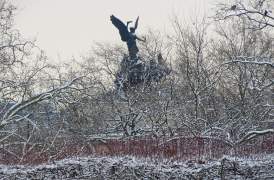
The pictures on this page were mostly taken in the snow of Jan 2013, forming a brief walk from the Victoria Memorial, into Green Park, thence to Hyde Park Corner and just inside that park. The pictures really cannot be appreciated in small size, so I would urge you to click on the small pictures to see them enlarged. We start with the Victoria Memorial, Thomas Brock’s masterpiece, working with the architect who remodelled Buckingham Palace, Aston Webb. Our first picture, below, shows the allegorical group of The Arts, with Big Ben in the background. The reclining figures give plenty of space for snow to collect out of the light wind, and together with a fairly thick dusting over the upper surfaces of the head, torso and limbs, we have a result which is more snow than exposed blackness of the figures.
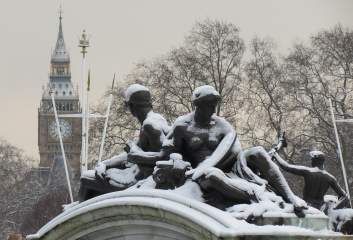 Group from the Victoria Memorial.
Group from the Victoria Memorial.
By contrast, here are two of the Lion groups, the contribution of New Zealand to the ensemble. In the Manufacture group on the left, the lion has a snow mask as if created by some traditional African wood-carver. The Agriculture group on the right is more heavily covered, and the whiteness of the allegorical figure’s scythe gives an unfamiliar accent to the work.
Manufacture and Agriculture groups, Victoria Memorial. 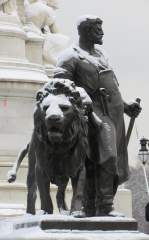
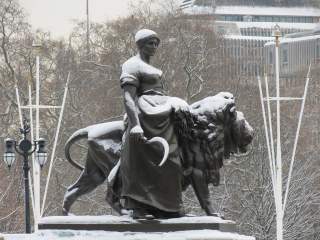
Two more pictures, of the white marble sculpture. Rather than the Victoria herself, or the accompanying massive allegorical groups, we have two cherubic examples. Firstly on the gatepost we have one of the pair of putti emblematic of Canada, more noticeable for the snow-covered branches forming the backdrop than the light dusting on the figure (the figure is still rather pale from cleaning for the Olympics). The figure on the right is an infant tucked in under the heavy robes of the figure of Motherhood on the central memorial, with the snow adding to the sense of snuggling in away from the cold, and compositionally, giving emphasis to the line from flank to kneel and down to the outstretched foot.
The Victoria Memorial is adjacent to Green Park, and at the other end of that, by Green Park Station, is the Diana the Huntress statue, an excellent work by the little known modern sculptor E. J. Clack. (See this page for more). The snow forms a single mass across head, shoulders, back and flank.
Travelling westwards to Hyde Park Corner, our view from below gives us only a slight coating to the chests of the horses and Peace figure of Adrian Jones’s Quadriga, atop Constitution Arch. The view of the group from within Hyde Park, at the top of this page, is far more satisfactory, with the figures arising from a fairy-tale landscape. On the northern, Piccadilly side, we have the nude figure of David, centrepiece of the Machine Gun Corps Memorial for World War I, whose exposed position means only a scanty amount of snow is found, the main effect being the reflectivity from the white all around and below causing the statue to appear rather lighter than normal. Derwent Wood was the sculptor, rather more familiar for his female nudes than his male ones. This site does not make a feature of modern non-representative or figural works, but below right is a picture of the New Zealand World War II memorial, rather stark against the white ground. Here also is Wellington ahorse, with accompanying foot soldiers, with a complete upper coating of snow looking like a deliberate addition to the sculpture. The strong neck of the horse is brought into particular prominence, and the characteristic stoop to the shoulders of the Iron Duke in his older portraits, seen otherwise to best effect in the standing statue by Matthew Noble in Manchester (see this page). J. E. Boehm was the sculptor of this London one, and the subtly posed soldiers around the base.
The Quadriga, Machine Gun Memorial, New Zealand Monument, Wellington, and accompanying figures. 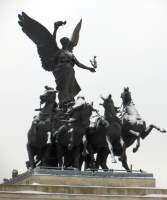
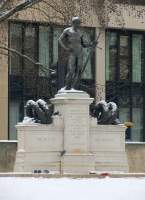
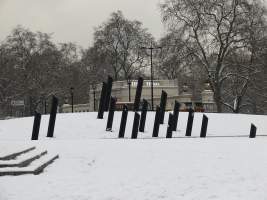
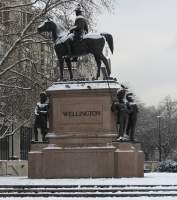
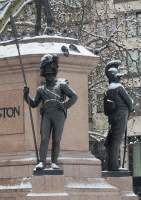
But most remarkable here at Hyde Park Corner is the transforming effect the snow has on Sergeant Jagger’s Artillery Monument. The white ground and sky make the monument, against the backing of St George’s Hospital (by William Wilkins, the architect of the National Gallery), a combination of variations of pale hues, most satisfactory. The best view though is round the side, where the fallen soldier is completely blanketed as if in a white shroud.
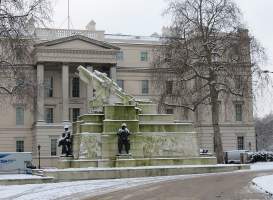
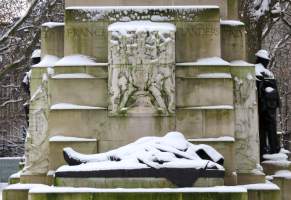 C. Sergeant Jagger's Artillery Monument.
C. Sergeant Jagger's Artillery Monument.
We cross the road to Hyde Park, but before entering, go behind Apsley House to see Byron. This statue (further described on this page), in which the sculptor Richard Belt rather surpassed himself, always looks rather marooned on his traffic island, and in summer tends to be concealed behind the foliage of the plane trees. But here, with a thick sprinkling of snow, and surrounded by the decorative snow-covered fruits of those same plane trees, he looks some fantastical and almost futuristic figure. Certainly more poetic.
Inside the entrance to Hyde Park then. There are many different views we could choose of the Achilles, Sir Richard Westmacott’s great tribute to Wellington, and here are two. The almost monochrome view from a distance shows the elliptical silhouette of Achilles’ shield, but the warrior himself has enough snow on chest and leg so that he cannot be seen as silhouette, but with satisfying solidity. From closer up, as with some of the other black bronze statues, the reflection of cold winter light from the snow around gives a paler, silvery cast to the figure, particularly effective on the broad, muscular torso and thigh.
Wellington Monument, by Sir Richard Westmacott. 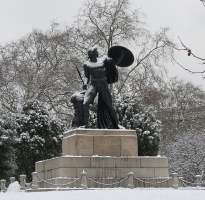
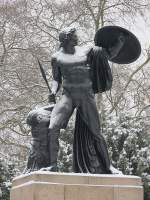
Close by is a group, dramatic in pose to begin with, made more so by the snow and frozen surround – it is the Cavalry Monument, by Adrian Jones. St George sits on his horse above the curled, scaly body of the defeated dragon, the pose of the horse and the man, and the curve of crocodilian dragon-body highlighted and enhanced by the white coating, the sense of something out of mythology increased by the snow-laden branches behind. Close to the monument, we see the face of the knight, enclosed in his armour and helm, made paler and more harsh by its surround.
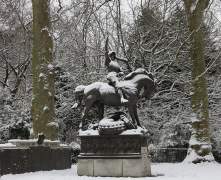
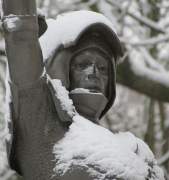 Adrian Jones's Cavalry Monument.
Adrian Jones's Cavalry Monument.
Visits to this page from 13 Mar 2014: 6,579
Albert Memorial in the snow // Great Exhibition Memorial in the snow
Victoria Memorial main page // Hyde Park Corner // London sculpture // Sculpture in England // Sculptors